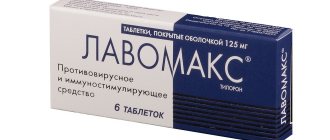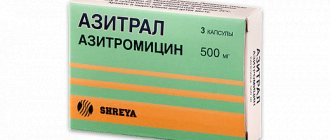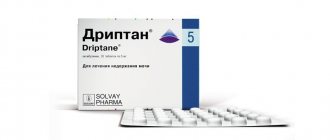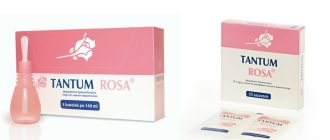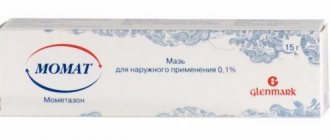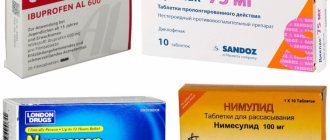The tactics for treating infectious and inflammatory pathologies of the respiratory tract should pursue two main goals - stopping the reproduction of bacteria and freeing the respiratory tract from mucus. The inhalation antibiotic Fluimucil IT, produced by the ZAMBON pharmacological enterprises in Italy, copes well with this task. In order to obtain a therapeutic result from Fluimucil, it must be used in accordance with the recommendations of the instructions and in consultation with a doctor.
pharmachologic effect
The substance is a combination of an antibiotic and mucolytic drug.
Thiamphenicol has a wide spectrum of action on bacteria that cause respiratory tract infections - both gram-positive (streptococci, clostridia, staphylococci) and gram-negative (neisseria, Haemophilus influenzae, salmonella, yersinia, E. coli).
Acetylcysteine actively dilutes sputum and purulent discharge, promotes sputum discharge, reducing viscosity.
Acetylcysteine promotes better penetration of thiamphenicol into the lung tissue and prevents the adhesion of microorganisms to the mucous membrane of the respiratory system.
special instructions
During the period of use of Fluimucil-antibiotic IT, it is necessary to monitor the peripheral blood picture. If there is a decrease in the number of leukocytes (less than 4000 in 1 μl) and granulocytes (more than 40%), therapy should be discontinued.
Contact of the solution with rubber and metal surfaces must be avoided.
For inhalation, it is recommended to use a compressor nebulizer, which should be adjusted so that the sprayed particles have a size of 3 to 20 microns. It is advisable to use a nebulizer made of plastic or glass. If some parts of the device are rubber or metal, they must be washed with water after use.
Impact on the ability to drive vehicles and complex mechanisms
According to the instructions, Fluimucil-antibiotic IT does not affect the ability to drive vehicles and other potentially dangerous and complex mechanisms.
Indications for use
- damage to the ENT organs and upper respiratory tract ( sinusitis , otitis , laryngotracheitis );
- diseases of the lower respiratory system ( bronchitis , lung abscess , pneumonia , bronchiectasis, cystic fibrosis, emphysema , whooping cough , bronchiolitis );
- treatment and prevention of infectious and obstructive complications after tracheostomy, thoracic surgery (atelectasis, bronchopneumonia );
- preparation for aspiration of bronchial secretions and bronchoscopy;
- in order to improve drainage in case of concomitant pulmonary infections (including tuberculosis , the presence of cavernous lesions).
Contraindications
Despite the benefits and relative safety of the drug, it has contraindications that must be taken into account before starting a therapeutic course. Absolute contraindications include intolerance to the main or additional component of the drug, as well as a tendency to allergic manifestations.
In addition, the drug is not prescribed for severe kidney and liver diseases, as it can negatively affect the functioning of important organs. From a pharmacological point of view, the drug is not harmful to the body if used correctly. However, the antibacterial component can negatively affect health.
A relative limitation for prescribing the drug will be the recovery period after severe surgery or injury. For elderly patients with a history of heart failure, coronary heart disease or angina, the drug is prescribed less often and only under supervision.
Another strict contraindication is leukopenia and thrombocytopenia. Severe anemia will also be an obstacle to treatment. Fluimucil is not prescribed to children under 2 years of age with kidney and liver diseases, as it can lead to serious complications.
Instructions for use Fluimucil - IT antibiotic (Method and dosage)
Use intramuscularly in the dose:
- adults: 1,500 mg per day in 3 divided doses;
- children under three years of age 125 mg twice daily;
- children from 3 to 7 years - 250 mg twice a day;
- for children from 7 to 12 years old, 750 mg per day, divided into 3 injections.
For newborns up to 2 weeks, as well as premature infants, use a dose of 25 mg/kg body weight per day.
How to dilute for inhalation?
For adults, 500 mg of dry substance is dissolved in 4 ml of water for injection and divided into 2 doses per day (2 ml each). Inhalations for children are prepared in the same amount of water for injection as for adults (4 ml), dissolving 250 mg of powder and also used twice a day.
Locally for washing the paranasal sinuses, incl. after surgical interventions, for endotracheal administration through a tracheostomy, bronchoscope or endotracheal tube, the powder is dissolved using water for injection in an amount of 4 ml, 500 mg for adults and 250 mg for children.
For otitis and diseases of the nasopharynx, 2-4 drops are instilled into the nasal passage or ear canal.
In case of appropriate indications, the dose of the drug can be doubled.
In newborns, premature and elderly patients, do not increase the dose.
The instructions for the antibiotic determine the course of treatment with the drug for no more than 10 days.
Release form and composition
- lyophilisate for the preparation of a solution for injection and inhalation: a plate-like mass of pale yellow or white color with a faint sulfuric odor (in a colorless glass bottle complete with solvent in an ampoule of 4 ml, 3 sets in a plastic tray, 1 tray in a cardboard box);
- lyophilisate for the preparation of solution for injection (in a glass bottle complete with a solvent in an ampoule of 4 ml, in a blister pack, 3 sets, in a cardboard box, 1 pack; in an ampoule, in a blister pack, 3 ampoules, in a cardboard box, 1 pack).
Solvent (4 ml) – water for injection: colorless, transparent liquid, odorless and tasteless.
1 bottle of lyophilisate for the preparation of solution for injection/injection and inhalation contains:
- active ingredient: thiamphenicol glycinate acetylcysteinate – 810 mg (which is equivalent to thiamphenicol in the amount of 500 mg);
- additional component: disodium edetate – 2.5 mg.
Some reception features
It is necessary to take Fluimucil Antibiotic only after an appropriate prescription from a doctor. Self-medication (including using the drug for inhalation) can lead to complications and side effects.
With long-term use of Fluimucil Antibiotic (more than 10 days), you need to regularly conduct a general blood test and biochemical study of creatinine and urea levels. At the first signs of suppression of hematopoiesis or decreased renal function, you should immediately stop taking the drug.
At the beginning of therapy with Fluimucil Antibiotic, especially in patients after surgical operations on the respiratory system, the amount of sputum increases, which the patient cannot cough up on his own. Therefore, postural drainage and bronchoaspiration should be considered in such cases. In bronchial asthma, inhalation of the drug sometimes leads to the development of bronchospasm.
Side effects
In most cases, adverse reactions develop if the instructions are violated, if the dosage is exceeded on your own, or if the therapeutic course is extended.
The most common complications are the following:
- Nausea and vomiting not associated with food intake. The complication is associated with the penetration of drug vapors into the tissues of the respiratory organs. In this case, the patient receives symptomatic treatment, which eliminates the symptoms and normalizes the condition.
- Headache and dizziness also develop quite often. In this case, it is recommended to stop the procedure. In most cases, this is enough to improve the condition. If the symptom always appears during inhalation, it is recommended to discontinue the drug.
- A rash and redness on the skin is evidence of the development of an allergic reaction. It is recommended to immediately stop using the product and start taking antiallergic medications.
- Prolonged reflex cough caused by irritation of the mucous membrane of the respiratory tract. In this case, treatment is most often stopped because the condition may worsen.
- Swelling of the mucous membranes of the throat, causing attacks of suffocation. If such complications occur, treatment is stopped immediately, the patient is given hormonal drugs that quickly relieve swelling.
- Bronchospasm develops quite rarely and is manifested by increased frequency and difficulty breathing, and changes in skin tone. Assistance must be provided to the patient immediately, as the likelihood of death due to suffocation increases.
If any complication occurs, it is recommended to immediately stop using the product. Doctors prescribe symptomatic therapy, and if necessary, the patient is hospitalized.
Pharmacodynamics
Fluimucil is a mucolytic drug. The pharmacological effect of the drug is due to the presence of the active component in its composition. It has a direct effect on the chemical structure of sputum, namely it breaks down disulfide bridges. Therefore, the drug effectively thins mucus and reduces viscosity. It lags behind the walls of the bronchi more easily and is released more quickly. Retains its activity against purulent exudate.
Mucolytic drugs - purpose
The active component helps to suppress the inflammatory process and remove toxic elements.
In parallel with the mucolytic effect, the active substance Fluimucil activates the nonspecific mechanism of the respiratory mucosa. Acetylcysteine also has antioxidant and detoxifying properties.
When using the drug for the purpose of prevention, a decrease in the frequency and severity of relapses is observed in patients with chronic bronchitis and cystic fibrosis.
Pharmacokinetics
When taken orally, rapid absorption of the drug is observed. The maximum level in the blood is observed after 1–3 hours. Bioavailability of the drug is 10%. For the most part, the active component of the drug is distributed in the bronchial mucus, lung tissue, liver and kidneys. The drug penetrates the placenta.
Excreted in urine in the form of inactive metabolic products. The half-life reaches 1 hour, with cirrhosis of the liver the time increases to 8 hours.
Combination with other means
Fluimucil IT antibiotic for inhalation can be used in combination with other medications, since it is absorbed into the blood in small doses. When used simultaneously with Nitroglycerin, an increase in the effectiveness of the latter is observed.
If the drug is combined with drugs that contain codeine and suppress the cough reflex, the likelihood of sputum stagnation in the bronchi and lungs increases.
It is not recommended to use Fluimucil simultaneously with antibiotics from the tetracycline group, since the effect of all drugs is weakened. Combining the finished solution with other medications in the same form is not allowed. It is prohibited to add mucolytics in the form of a solution, as well as agents from another group, into the nebulizer chamber during the procedure.
Any combination of drugs with Fluimucil must be approved by a doctor.
Analogs
The uniqueness of Fluimucil is manifested in the fact that it has no direct, that is, structural, analogues. But among similar drugs, you can select pharmacotherapeutic equivalents of this medicine, containing mucolytics, antibiotics or combinations of these substances. You can dilute the following mucolytic agents yourself with regular saline solution:
- ACC injection;
- Ambroxol;
- Gedelix;
- Mukaltin;
- Lazolvan.
The instructions for nebulizers usually contain recommendations in what ratio to dilute the components and how much liquid to pour into the chambers for inhalation.
conclusions
Inhalation therapy is a popular method of auxiliary treatment of colds. Fluimucil (inhalation solution) softens viscous bronchial secretions and prevents the proliferation and spread of pathogenic microbes. Due to the antibiotic content in the medication, it can be purchased by prescription and should be prescribed by a specialized specialist.
Previous
Inhalation preparations Foster inhaler: instructions for use
Next
Preparations for inhalation Berodual for inhalation instructions for use in a nebulizer for children and adults

